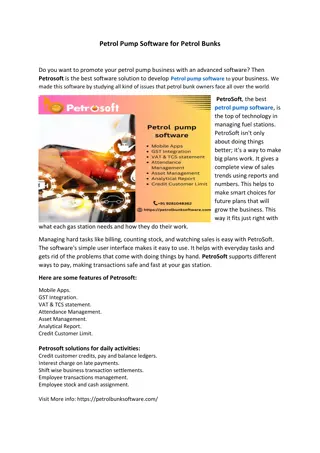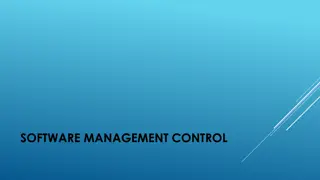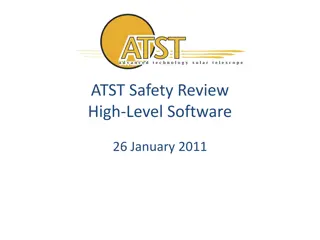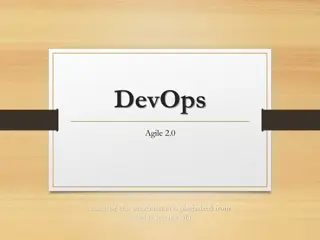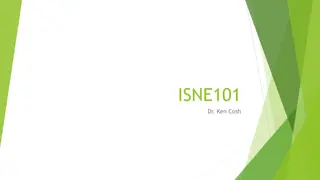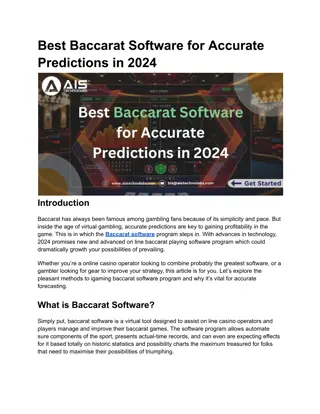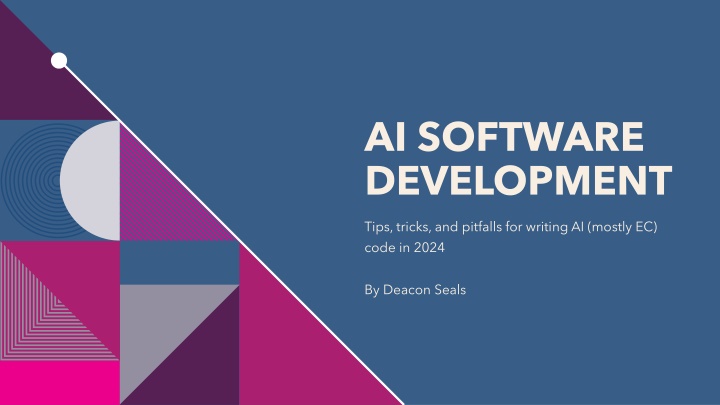
Tips and Pitfalls for AI Software Development in 2024 by Deacon Seals
Discover insights on AI software development from Deacon Seals, covering tips, tricks, and pitfalls for writing AI code, and valuable experiences in the field. Learn about the current state of AI computing, project success strategies, tool awareness, and more.
Download Presentation

Please find below an Image/Link to download the presentation.
The content on the website is provided AS IS for your information and personal use only. It may not be sold, licensed, or shared on other websites without obtaining consent from the author. If you encounter any issues during the download, it is possible that the publisher has removed the file from their server.
You are allowed to download the files provided on this website for personal or commercial use, subject to the condition that they are used lawfully. All files are the property of their respective owners.
The content on the website is provided AS IS for your information and personal use only. It may not be sold, licensed, or shared on other websites without obtaining consent from the author.
E N D
Presentation Transcript
AI SOFTWARE DEVELOPMENT Tips, tricks, and pitfalls for writing AI (mostly EC) code in 2024 By Deacon Seals
PLEASE KEEP IN MIND Software development is an inherently subjective topic filled with lots of opinions There is no one size fits all approach to writing software as any supposedly optimal approach often varies by expertise, resources, and domain Goals: Provide an awareness of the current state of AI computing Give tips for project success Make you aware of tools Highlighting when to use different tools 2
ABRIDGED QUALIFICATIONS Undergrad (2013-2018) Missouri University of Science and Technology Electrical Engineering, Computer Engineering, and Computer Science 2 years as a design lead on a student design team Year 1 Lead of Electronics One-person team under higher-ranking project lead Poorly planned project that failed Learned a lot about how not to plan a project Year 2 Lead of Innovation Recruited students from my majors Leveraged existing experiences to design a project I could solo if necessary Won 2nd place innovation reward at international engineering competition Rapid prototyping internship between design lead positions Led 2 semester senior design team of 2 other electrical engineers Machine that creates artificial muscles from fishing line 3
ABRIDGED QUALIFICATIONS Teaching Assistant Started as undergrad in 2018 for AI course Added EC in 2018 as grad student Became Lead TA in 2019 Assignment Curriculum Designer in 2021 Mentor TA starting in 2022 Research Started on poorly-planned solo project in 2018 Joined CEADS-LIN in 2019 Collaboration with Los Alamos National Lab Became Technical Project Lead in 2020 More than a dozen members at peak Published the Maelstrom framework at GECCO 23 pip install maelstrom-evolution Served as a mentor or advisor on at least a dozen other projects Senior capstones, Master s theses, research projects, etc. Current instructor of COMP 2210 and all CSSE sections of ENGR 1110 4
SOME OBSERVATIONS Many demonstration of what not to do Fear Ambiguity is the mind-killer Beware scope creep The sunk-cost fallacy Reluctance to abandon something because of heavy investment Project failure can be the most valuable experience (in moderation and with added effort) Engineers and software developers love to make everything from scratch Partially driven by ambition (wanting to make something!) Sometimes an unwilling to learn new tools Not throwing stones - I m not a graceful learner without an immediate knack 5
SOME OBSERVATIONS Human nature is always at play Being a human is weird/hard Useful characteristics (in excess) can stifle a project Tenacity -> stubbornness Flexibility -> flighty Optimism -> audaciousness Ambitiousness -> unrealistic Creativity -> scope creep Project members sometimes lose the plot Frequent context switching between projects and limited bandwidth Limited consideration of project outside of meetings Can result in knee-jerk tasking (scope creep) 6
SOME OBSERVATIONS Human nature is always at play People will go through great lengths to minimize attention and/or critical thought Hope for unsolvable or niche problems (e.g., novel compiler bugs) Hail Mary solutions Delete and rewrite code Ask ChatGPT Don t Make Me Think: A Common Sense Approach to Web Usability - Steve Krug Discusses tendency to personify inanimate objects Requires less thought Hypothesizes that there s an evolutionary benefit from thinking less Brains use a lot of energy/calories! 7
COMMON PITFALLS Blind/dogmatic use of a programming language, tool, or technique When you have a hammer, everything looks like a nail Failing to prioritize project success Building everything from scratch and/or reinventing the wheel Sacrificing progress for the sake of a tangent Adding features (scope creep) Using a project to learn a new language (or similar) Never clearly establishing project goals or scope Failure to adapt to changing requirements or needs 8
OVERVIEW PROJECTS DEVELOPMENT TOOLS Starting a project Executing a project Working on a team Tips for research Current state of computing for AI Picking a programming language When to make a new tool Lots of slides about Python development Recommendations to build on top of 9
PROJECTS 10
STARTING A PROJECT Is the primary goal learning a skill or completing a task? Beware inadvertently swapping these during the project Differentiate between these projects Establish dedicated learning projects if necessary Define clear project goals and scope Establish criteria for project success E.g., the existence of a specific set of features, data on the performance of a new mutation operator, etc. Determine milestones required to satisfy success criteria and meet project goals Pick the right tools for the job (more on this later) 11
EXECUTING A PROJECT Identify a minimum viable product (MVP) What components are hard requirements for project success? What components are optional? Can you complete the MVP and make optional components stretch goals? Be pragmatic about project progress when considering tangents Is a new feature/task necessary for project success? Will a new feature/task significantly improve the success of the project? Be aware of timelines and deadlines (and beware scope creep) Be prepared for failure and changing needs/requirements Fail fast! Determine failure criteria for rapid iteration 12
WORKING ON A TEAM Effective teams have 2 obvious characteristics: Accountability Establish clear expectations/responsibilities Check progress/completion as a group Good communication Clear Transparent/honest Robust (especially for critical systems) 13
TIPS FOR RESEARCH Build off existing work Much easier to determine originality of ideas Good way to get citations Do literature review early Determining work originality after the fact is nerve- racking Allows you to identify problems your work could address Think like a scientist! Define clear, measurable goals from the onset Including success and failure criteria Failure as a finding is a valuable project characteristic 14
DEVELOPMENT 15
CURRENT STATE OF COMPUTING FOR AI Historical context: AI researchers have endured several periods where funding was difficult to obtain Often referred to as the AI winters Causes XOR problem Limitations of computation resources Important concepts: The slow, but eventual, death of Moore s Law AI winning the hardware lottery 16
Moores Law Observation made by Gordon Moore Co-founder of Fairchild Semiconductor and Intel Noted in 1965 that transistor density doubled every 12 months Greater transistor density enables: Increased operating frequency (faster chips) Decreased energy consumption More stuff per chip (memory, compute cores, etc.) Programming Languages 17
Moores Law Based on observations about how transistor manufacturing technology was advancing Improvements to precision enabled smaller transistors There are physical limits to how small transistors/wires can be Rate of doubling has slowed over time 12 months 18 months 24 months Is Moore s Law dead? https://en.wikipedia.org/ wiki/Moore%27s_law Programming Languages 18
Post Moore-tem Computing Performance of general CPU cores will stagnate Add more cores Make chips bigger Overclock and use more aggressive cooling Amdahl s law Speedups from parallelization are limited by sequential program sections Most algorithms/programs are only partially parallelizable Programs contain sections that must be evaluated sequentially These sections place an upper bound on speedups from parallelization Programming Languages 19
Post Moore-tem Computing Change computing paradigms Quantum computing Application-specific integrated circuits (ASIC) Hardware specialized for only a specific task Floating point coprocessors Eventually became part of x86 architecture Bitcoin miners Specialized hardware for accelerated hashing Graphics processing unit (GPU) Designed for graphics rendering tasks Specialized hardware for matrix operations Programming Languages 20
The Hardware Lottery In 2012/2013, AlexNet demonstrated the ability to accelerate deep learning with a graphics card (GPU) Achieved unprecedented performance on a highly- competitive computer vision problem Extreme acceleration of deep learning via GPU since referred to as winning the hardware lottery Serendipitous ~80x speedup by capitalizing on previously unrelated technological advances Set off a huge boom in deep learning research still going today First viable path around death of Moore s Law Programming Languages 21
The Hardware Lottery Nvidia capitalized on this with CUDA Heavy investment to make CUDA industry standard CUDA implemented in C/C++ Deep learning built ecosystem of libraries around CUDA Many early libraries in C++ Most current libraries are Python bindings for C/C++ backends Google: TensorFlow and JAX Meta: PyTorch Other fields try to cash in on the hardware lottery Simulations/Scientific Computing Statistics/Data Science My own research in Evolutionary Computing Java still does not have GPU support Programming Languages 22
https://www.reddit.com/r/ProgrammerHumor/comments/wy7uxi/even_html/ 23
PICKING PROGRAMMING LANGUAGES View programming languages as a tool Use the right tool for the job Let existing resources and tools guide you Are there existing implementations of important components of your target application? E.g., you need to use a complex physics simulation that is only implemented in C++ What languages are these implementations in? Of the programming languages with rich library support, which one best suits your needs? Pick languages at the right level of abstraction for your project Don t ignore development time or only focus on compute time! Human development time is often expensive Let computers work for you Consider combinations of programming languages Consider high-level acceleration tools (e.g., GPU acceleration in Python) My advice: only use low-level languages if you have a specific reason 24
WHEN TO USE A LOW- LEVEL LANGUAGE Required tools are implemented without a high-level interface A complex physics simulation that only provides an interface in C Your application is prohibitively computationally expensive, and that cost can t be alleviated by higher- level parallelism or acceleration Consider only implementing required portions in a low-level language Your project has the specific goal of learning a low-level language 25
WHEN TO MAKE A NEW TOOL Scenario 1: there no existing tools that satisfy your project s required capabilities I.e., the thing you need completely does not exist This does not include performance requirements Scenario 2: tools exist that satisfy your project s required capabilities, but they suck enough Performance of existing tools is so poor that creating a replacement would be a meaningful contribution to your field Your use case of existing tools is so ill-suited to their intended use case that creating an alternative or wrapper would be a meaningful contribution to your field You have attempted to use existing tools and found their documentation so incomplete that using their code is impractical and creating an alternative or wrapper would be a meaningful contribution to your field Litmus test: would a new tool be a meaningful contribution to your field? Are there specific improvements you could provide or use cases you could expand support to? 26
LOTS OF SLIDES ABOUT PYTHON Python became incredibly popular in the AI community Replaced LISP, Java, C++, and other lower-level languages Library support is very good Mature, well-optimized libraries developed and funded by Google, Meta (Facebook), and others Frequently use faster, low-level languages under the hood (more on this later) Python has a high level of abstraction Great for rapid prototyping First-party libraries like multiprocessing and random are performant and feature rich Flexibility enables lots of footguns (more on this later) 27
REQUIRED DEVELOPMENT TIME BY PROGRAMMING LANGUAGE Pure Python* Python with low-level components Pure low-level language development 28
CAVEATS OF PYTHON Prone to abusive programming practices Using dictionaries instead of classes Inconsistent use of variable names and data types High-level abstractions can obscure computational cost Example: if individual in population: # do something O(n) if population is a list O(1) if population is a set or dictionary 29
CAVEATS OF PYTHON Python doesn t support sharing Python variables in memory between processes Must use shared ctype variables or a manager process that host variables Python has quirks that are unintuitive when compared to other languages Implicit pass-by-reference and pass-by-value Multithreading vs multiprocessing 30
PYTHON IS SLOW Optimized compiled code is typically faster than equivalent interpreted code (Python) Algorithmic time complexity still dominates language-based performance differences in most cases Development time is often far more expensive/valuable than compute time The primary exceptions to this are caused my severe computation resource constraints (e.g., embedded devices or very large amounts of data) 31
MAKING PYTHON FAST ENOUGH USING A C/C++ CORE AND/OR ACCELERATORS PyTorch, Tensorflow, NumPy, JAX, scikit-learn, iGraph, and many more A very common trend for domains known for high computation cost JUST-IN-TIME COMPILATION Compile portions of Python code at runtime (e.g., PyPy, Numba, and JAX) Potential performance improvements vary by workload USE A PROFILER (PLEASE) python m cProfile -s tottime myPythonProgram.py 32
TIPS FOR WRITING BETTER PYTHON Know when to use different data structures List vs set vs heap Applicable to all programming languages Pay attention to data type and what s happening under the hood Membership check on list vs set Use multiprocessing pools and multiprocessing.pool.starmap_async() to easily parallelize function calls Know when to use multiprocessing (concurrent execution) vs multithreading (sequential execution) too 33
TIPS FOR WRITING BETTER PYTHON List comprehension can be faster than a for loop Be careful to maintain legibility though Tutorial: https://realpython.com/list-comprehension- python/ Generators can improve memory utilization and compute time Tutorial: https://realpython.com/introduction-to-python- generators/ 34
WHAT ABOUT USING PYTHON WITH OTHER LANGUAGES? PyO3 Cython C extensions for Python Not to be confused with CPython (the default Python interpreter written in C) Rust bindings for Python Creates native Python modules from compiled Rust Interoperable with PyPy just-in-time compiler Generates C/C++ code and Python wrapper code Allows Rust code to call Python as well C functions can be called from pure Python wrapper functions 35
TOOLS 36
NOTABLE LIBRARIES JAX Tensorflow / Pytorch Deep learning libraries for accelerated gradient-based optimization Feature rich with some caveats Accelerated linear algebra for Python Includes JIT compiler Auto-differentiation and GPU/TPU support Gym OpenSpiel RL environments with a standardized interface Brax (gym in JAX) May have migrated RL environment for games C++ (typically) wrapped for Python use Link 37
NOTABLE LIBRARIES evosax QDax Evolution strategies in JAX Accelerated neuroevolution library Primarily focused on CMA-ES Accelerated Quality-Diversity QD neuroevolution library DEAP Stable Baselines3 Distributed Evolutionary Algorithms in Python GP, GA, MOEA, CMA-ES Reliable reference implementation of deep RL algorithms Useful if applicable 38
LEGACY LIBRARIES ECJ PyTorch NEAT Java-based Evolutionary Computation Research System Useful if your application domain meshes with Java Support for wide variety of NEAT algorithms Uses a very old version of PyTorch 39
CLOSING REMARKS Be realistic and practical Set project goals and stick to them Fail fast Use the right tools for the job Learning new tools is valuable experience Form good reasons for what you do and don t like about existing tools Your time is valuable Let computers work for you Stand on the shoulders of giants (and all that) 40
THANK YOU Questions?



